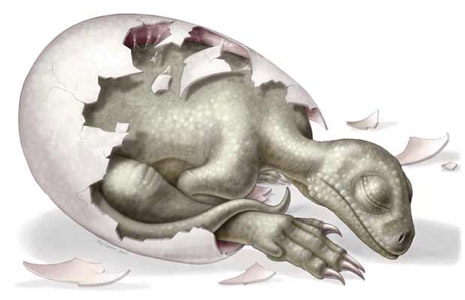Early Jurassic Dinosaur Eggs Provide Clues to Dinosaur Diversity
A team of scientists have been going to work on an egg, as they study 190-million-year-old dinosaur eggs and the tiny embryos they contain in a bid to learn more about how dinosaurs diversified.
The research’s lead author, palaeontologist Robert Reisz of the University of Toronto stated that the study:
“Opens an exciting window into the early history and evolution of the dinosaurs.”
Dinosaur Eggs
The fossils of two unborn baby dinosaurs, still preserved in their eggs, were discovered in South Africa in 1976. They had remained in storage for more than three decades and it was only with the development of new imaging techniques and powerful X-ray based scanning devices that has allowed scientists to explore and study their contents.
The eggs were laid by a primitive dinosaur known as Massopondylus (the name means “massive vertebrae”). Massopondylus was a member of the prosauropods, a group of long-necked, lizard-hipped dinosaurs regarded by many scientists as a basal member of the Sauropodomorpha – a group of plant-eating dinosaurs that were to evolve into the largest land living animals of all time, giants like the Late Jurassic Diplodocus and Titanosaurs such as Saltasaurus.
For models of sauropods including titanosaurs: Wild Safari Prehistoric Life Models and Figures.
Massopondylus Embryos
The Massopondylus embryos, dating from approximately 190 million years ago, (Pliensbachian faunal stage) are believed to be the oldest embryos ever found from a land dwelling vertebrate. The study, published in this month’s issue of the Journal of Vertebrate Palaeontology was co-written by two of Reisz’s colleagues – David Evans and Diane Scott, aided by U.S. based scientist Hans-Dieter Sues of the Washington-based National Museum of Natural History.
The twenty centimetre long, fossil embryos have provided the scientists with a great deal of information on how these babies once hatched would have developed into five metre long adults – the embryos are helping scientists to understand more about dinosaur growth and development, the study of the development of individuals to an adult state is called ontogeny.
An Artist’s Impression of the Baby Massospondylus

Picture credit: Heidi Richter
Commenting on the research work, Dr Reisz added:
“Prosauropods are the first dinosaurs to diversity extensively and they quickly became the most widely spread group, so their biology is particularly interesting as they represent in many ways the dawn of the age of dinosaurs.”
The exact taxonomic relationship between the prosauropods and sauropods is still debated, some scientists assert that the prosauropods are ancestral to the rest of the Sauropoda clade, whereas others argue that they are not basal to the group. However, a study of such perfectly preserved baby dinosaurs is providing researchers with a new understanding of just exactly how these dinosaurs grew and developed.
How Dinosaurs Grew and Developed
To read an article about the discovery of an ancestral Sauropod: The Mother of all Sauropods?
While the embryos had “relatively long front limbs and disproportionately large heads,” the research paper reports, the five metre long adults they would have become in maturity “had relatively tiny heads and long necks” typical of Diplodocus and its sauropod cousins. The embryos are providing the research team with a better understanding of distil growth, as many vertebrate babies have different body proportions than their adult forms. This is helping to highlight connections between the development of dinosaur infants and that of other back-boned animals including mammals.
In a summary of the team’s findings it is stated that:
“In at least one way, Massospondylus development resembles that of humans; infancy is awkward, and a more erect stance and evenly proportioned body only comes later.”
The fact that the babies may be born relatively helpless also provides a valuable insight into dinosaur parental care. The scans of the embryos reveal that the babies had no teeth and this, combined with their awkward bodies suggests that the hatchlings may have been looked after for some time by their parents – altricial care. If this is proved to be the case, then these fossils also represent the oldest record of parental care.
In the past, scientists assumed that huge sauropods were too large and ungainly to run the risk of having young animals under their feet. It was thought that sauropods laid eggs in a nest but then abandoned the nest leaving any hatchlings to fend for themselves. This study when discussed in conjunction with the recent trace fossil of a sauropod trackway which suggest young sauropods walking close to an adult, may provide clues to indicate that these leviathans may have had a greater degree of parental care than previously thought.
To read more about the sauropod trackway: Running with Baby Dinosaurs






Leave A Comment